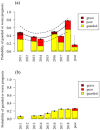Modeling population effects of the Deepwater Horizon oil spill on a long-lived species
- PMID: 34918835
- PMCID: PMC9545999
- DOI: 10.1111/cobi.13878
Modeling population effects of the Deepwater Horizon oil spill on a long-lived species
Abstract
The 2010 Deepwater Horizon (DWH) oil spill exposed common bottlenose dolphins (Tursiops truncatus) in Barataria Bay, Louisiana to heavy oiling that caused increased mortality and chronic disease and impaired reproduction in surviving dolphins. We conducted photographic surveys and veterinary assessments in the decade following the spill. We assigned a prognostic score (good, fair, guarded, poor, or grave) for each dolphin to provide a single integrated indicator of overall health, and we examined temporal trends in prognostic scores. We used expert elicitation to quantify the implications of trends for the proportion of the dolphins that would recover within their lifetime. We integrated expert elicitation, along with other new information, in a population dynamics model to predict the effects of observed health trends on demography. We compared the resulting population trajectory with that predicted under baseline (no spill) conditions. Disease conditions persisted and have recently worsened in dolphins that were presumably exposed to DWH oil: 78% of those assessed in 2018 had a guarded, poor, or grave prognosis. Dolphins born after the spill were in better health. We estimated that the population declined by 45% (95% CI 14-74) relative to baseline and will take 35 years (95% CI 18-67) to recover to 95% of baseline numbers. The sum of annual differences between baseline and injured population sizes (i.e., the lost cetacean years) was 30,993 (95% CI 6607-94,148). The population is currently at a minimum point in its recovery trajectory and is vulnerable to emerging threats, including planned ecosystem restoration efforts that are likely to be detrimental to the dolphins' survival. Our modeling framework demonstrates an approach for integrating different sources and types of data, highlights the utility of expert elicitation for indeterminable input parameters, and emphasizes the importance of considering and monitoring long-term health of long-lived species subject to environmental disasters. Article impact statement: Oil spills can have long-term consequences for the health of long-lived species; thus, effective restoration and monitoring are needed.
El derrame de petróleo Deepwater Horizon (DWH) en 2010 expuso gravemente a este hidrocarburo a los delfines (Tursiops truncatus) de la Bahía Barataria, Luisiana, causando un incremento en la mortalidad y en las enfermedades crónicas, y deteriorando la reproducción de los delfines sobrevivientes. Realizamos censos fotográficos y evaluaciones veterinarias durante la década posterior al derrame. Asignamos un puntaje pronóstico (bueno, favorable, moderado, malo, o grave) a cada delfín para proporcionar un indicador integrado único de la salud en general. También examinamos las tendencias temporales de estos puntajes. Usamos información de expertos para cuantificar las implicaciones de las tendencias para la proporción de delfines que se recuperaría dentro de su periodo de vida. Integramos esta información, junto con información nueva, a un modelo de dinámica poblacional para predecir los efectos sobre la demografía de las tendencias observadas en la salud. Comparamos la trayectoria poblacional resultante con aquella pronosticada bajo condiciones de línea base (sin derrame). Las condiciones de enfermedad persistieron y recientemente han empeorado en los delfines que supuestamente estuvieron expuestos al petróleo de DWH: 78% de aquellos evaluados en 2018 tuvieron un pronóstico moderado, malo o grave. Los delfines que nacieron después del derrame contaron con mejor salud. Estimamos que la población declinó en un 45% (95% CI 14-74) relativo a la línea base y tardará 35 años (95% CI 18-67) en recuperar el 95% de los números de línea base. La suma de las diferencias anuales entre el tamaño poblacional de línea base y el dañado (es decir, los años cetáceos perdidos) fue de 30,993 (95% CI 6,607-94,148). La población actualmente está en un punto mínimo de su trayectoria de recuperación y es vulnerable a las amenazas emergentes, incluyendo los esfuerzos de restauración ambiental planeada que probablemente sean nocivos para la supervivencia de los delfines. Nuestro marco de modelado demuestra una estrategia para la integración de diferentes fuentes y tipos de datos, resalta la utilidad de la información de expertos para los parámetros de aportación indeterminable, y enfatiza la importancia de la consideración y el monitoreo de la salud a largo plazo de las especies longevas sujetas a los desastres ambientales. Modelado de los Efectos Poblacionales del Derrame de Petróleo Deepwater Horizon sobre Especies Longevas.
Keywords: análisis de salud; delfín; derrame de petróleo; dolphin; especie longeva; expert elicitation; health assessment; información de expertos; mamífero marino; marine mammal; modelo poblacional; oil spill; population model; slow-living species.
© 2021 The Authors. Conservation Biology published by Wiley Periodicals LLC on behalf of Society for Conservation Biology.
Figures





References
-
- Astfalck, L. , Cripps, E. , Gosling, J. , Hodkiewicz, M. , & Milne, I . (2018). Expert elicitation of directional metocean parameters. Ocean Engineering, 161, 268–276.
-
- Barratclough, A. , Gomez, F. M. , Morey, J. S. , Meegan, J. M. , Parry, C. , Schwacke, L. , Jensen, E. D. , & Smith, C. R . (2021). Biochemical and hematological biomarkers of reproductive failure in bottlenose dolphins Tursiops truncatus . Diseases of Aquatic Organisms, 144, 197–208. - PubMed
-
- Booth, C. , & Thomas, L . (2021). An expert elicitation of the effects of low salinity water exposure on bottlenose dolphins. Oceans, 2, 179–192.
-
- Caswell, H. (2001). Matrix population models: Construction, analysis, and interpretation. Sunderland, MA: Sinauer Associates.
Publication types
MeSH terms
LinkOut - more resources
Full Text Sources
Medical

